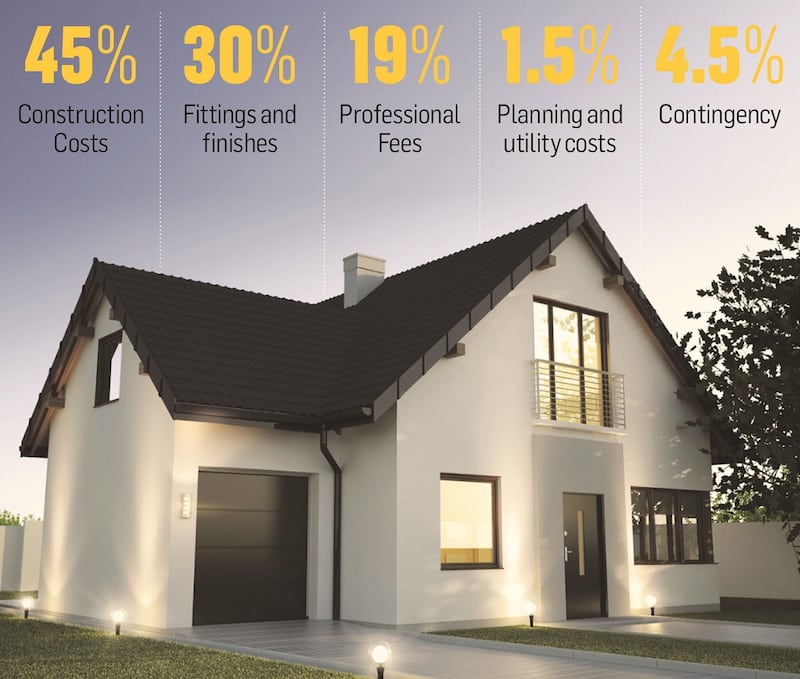We carried out a study recently of people planning a home improvement project this year and unsurprisingly nearly three quarters of respondents cited the budget as their biggest concern. Construction costs have risen at a dramatic rate in the past 18 months and are continuing to do so. There are a number of reasons, with increased labour and material costs being the most significant. But it means anyone planning any kind of renovation or construction work to their home is in a vulnerable position when it comes to fixing a budget. To demystify things I’ve taken an imaginary budget of €100,000 and broken it into percentages to show more clearly how much typically needs to be allocated to each area.

45 per cent – construction costs
You might think with a budget of €100,000 you’d have a lot to spend on the building work, but actually only €45,000 will go towards the core construction costs. This is the money that goes to the builder and it will include all materials, electrical and plumbing works, internal doors, skirtings and architraves and the fitting of all finishes and sanitary ware.
This money will not include the cost of things like windows, kitchens, bathroom fittings or supply of finishes but does include builder’s costs to fit these items. It also includes VAT at 13.5 per cent
30 per cent – fittings and finishes
This part of the budget typically refers to items you need to supply yourself and includes the kitchen, floor finishes, tiles and sanitaryware as well as any built-in joinery and smaller items such as door handles and feature light fittings.
Costs can vary widely for these items as a floor tile can cost anything from €10-€100 per metre and much more depending on what you choose. For a good level of finish however, you should allow about €30,000 to cover the total cost based on the example budget.
When shopping for these items get quotes from a number of different suppliers. The important thing is to make sure each company is working from the same brief. Even the most subtle of differences can have a huge impact on the total cost. If everyone is quoting for the same kitchen you can compare the quotes exactly, which will ensure you get the best deal.
19 per cent – professional fees
Fees are another cost that need to be factored in from the outset. If you are planning on working with an architect, speak to them about how their fee structure works. Is it percentage-based or a fixed fee? A percentage-based fee will mean that, if the budget were to increase the fee would also increase so this is important to factor into your cost plan.
Aside from the architect’s fees, you might also need to include fees for other consultants such as structural engineers, quantity surveyors, landscaping or lighting consultants. Based on this example budget you should allocate about €19,000 to cover these fees.
1.5 per cent – costs for planning and utility connections
If you need planning permission for the work you are proposing you will need to pay contributions to the local council. These will vary depending on the works you are planning. You may also need to relocate your gas and electric meters; there will be costs to the service providers for doing this work. You should budget about 1.5 per cent of your total budget (in this example €1,500) to cover these costs.
4.5 per cent – contingency
Once you have a firm idea of your budget you will need to set aside at least 10 per cent of the construction costs as a contingency for any unexpected extras. Building projects can often run up against problems that are impossible to predict from the outset so having a sum of money set aside to deal with these situations will give you great peace of mind. Based on this example your contingency allowance should be €4,500.
Other costs
If you need to move out while the works are ongoing you might need to rent. This can add significantly to your outgoings while the works are taking place so be sure to factor this in. Similarly will you need to pay for storage costs? Factor in furniture and accessories and any delivery costs plus removals to and from your home.
It’s really important from the outset that you decide on what you are comfortable spending and then use this as your total budget for the project. You might have a clear idea of what that figure is or you might want to get some help to figure out what your wishlist is going to cost and then pare back accordingly. Either way, it’s important you settle on a total amount and from there work out what that amount will need to cover.












